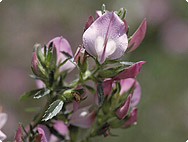
Ononis spinosa L.
Spiny Restharrow

History
In the 4th century B.C., Theophrastus produced the first botanical description of restharrow. In the first century A.D., Dioscorides and Pliny described the use of the plant as a remedy for urinary complaints and stones. In the later writings of Roman antiquity, Galen referred to the effect of ononis on increasing urine flow and decreasing the size of urinary stones. Lonicerus wrote: “This herb is the most excellent of stone-herbs which flushes out the stone and urine in man and animals, which is why it is also called stone-root. Our ancestors used to marinate this herb while it was still young and consume it throughout the year. It is highly praised in medicine. Bark and root soaked in wine, or marinated in wine and drunk, drive out the stone with force. They also drive out hidden warts (pointed condylomata) and heal them. Retained in the mouth, the wine relieves toothache.”The etymology of the name ononis presents some difficulties. The name is associated with the Greek ónonis, ánonis from Gr. ónos, «donkey» and the term oninemi, which means «useful». A combination of these two terms suggests that the plant was of use only to donkeys, the only animals that could eat it despite the sharp thorns on its side branches. These thorns are reflected in the species epithet spinosa. Hegi considers this interpretation improbable, although he himself can offer no better explanation. Dioscorides named the plant ónosma. The German name “Hauhechel” likens the plant to a spiky tool, the hackle, which was used to comb through flax. Many folk names point to it being used as a diuretic for man and animals (particularly horses) to combat the swelling in the legs caused by dropsy. Other names, such as "women’s war" and "plough-tail", indicate that the plant proved troublesome to women weeding and to ploughmen.

Botanical characteristics
Restharrow is a tall subshrub which grows to a height of 60 cm. It has a short rhizome and a ligneous taproot which can be up to 50 cm long. The upright stems which grow out of this are lignified at the base and slightly hairy. Numerous short shoots have developed into prickly thorns, but thornless varieties also exist. The lower leaflets are trifoliate and pinnate, while the upper ones are small and unifoliate with a long oval shape and dentate edges. The leaves are covered with very fine glandulous hairs. The striking butterfly-shaped flowers are pink or purplish in colour and grow in the upper angles between leaf and stem. The flowers are generally solitary but sometimes also grow in loose clusters. They produce soft-haired pods bearing rounded, lumpy seeds. The flowering period is from May to October.

Habitat
Restharrow is to be found in dry meadows and pastures, by fields and waysides, but also in peat areas and sand dunes. It favours sunny locations with weak loamy or chalky soils. Fertilizing causes it to disappear. The plant is rich in calcium and potassium and fixes nitrogen, which is why it helps improve the quality of poor sandy soils. It also improves the microclimate and moisture content of the soil. It is native to Europe, Asia Minor and the coast of North Africa and can be found up to a height of 1500 m. Restharrow used to be widespread, but is unfortunately becoming increasingly rare in our regions.

Processing Method
Bioforce uses wild-growing restharrow which is cut from May to July. It is macerated in alcohol while still fresh in order to obtain the mother tincture. The use of this herb has a long tradition in folk medicine. It was also prescribed in the old German homoeopathic pharmacopoeia (HAB). In the new pharmacopoeiae it is the root which is officinal. It is dug out in autumn, washed, chopped and dried. The fresh root emits a strong “goaty” odour. The components of the leaves and the roots of restharrow are very similar, which is why their effect is comparable.
A.Vogel Blog – Natural and Healthy
Inspiration for a healthy life!
HERBAMARE SOUP-ER SOUPS!
DOWNLOAD YOUR FREE RECIPE BOOKLET!
8 healthy, hearty and delicious homemade soups.
Supporting a healthier happier you
“Nature is just about the best thing we’ve got!“
Alfred Vogel's guide to leading a healthy and happy life
Healthy & nutritious dinner ideas
Get new recipes in your inbox every month. Sign up now